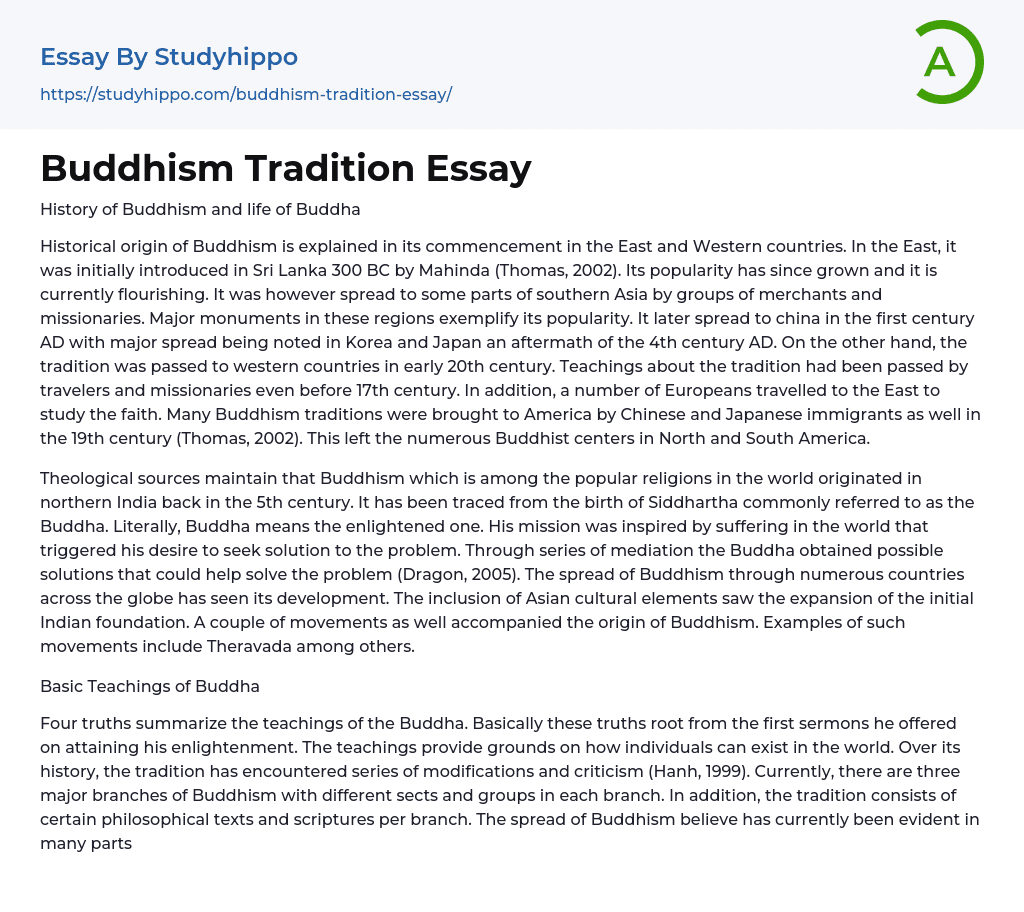History of Buddhism and life of Buddha
Historical origin of Buddhism is explained in its commencement in the East and Western countries. In the East, it was initially introduced in Sri Lanka 300 BC by Mahinda (Thomas, 2002). Its popularity has since grown and it is currently flourishing. It was however spread to some parts of southern Asia by groups of merchants and missionaries. Major monuments in these regions exemplify its popularity.
It later spread to china in the first century AD with major spread being noted in Korea and Japan an aftermath of the 4th century AD. On the other hand, the tradition was passed to western countries in early 20th century. Teachings about the tradition had been passed by travelers and missionaries even before 17th century. In addition, a number of Europeans travelled to the East to study the faith.
<
...p>Many Buddhism traditions were brought to America by Chinese and Japanese immigrants as well in the 19th century (Thomas, 2002). This left the numerous Buddhist centers in North and South America. Theological sources maintain that Buddhism which is among the popular religions in the world originated in northern India back in the 5th century. It has been traced from the birth of Siddhartha commonly referred to as the Buddha.
Literally, Buddha means the enlightened one. His mission was inspired by suffering in the world that triggered his desire to seek solution to the problem. Through series of mediation the Buddha obtained possible solutions that could help solve the problem (Dragon, 2005). The spread of Buddhism through numerous countries across the globe has seen its development. The inclusion of Asian cultural elements saw the expansion of the
initial Indian foundation.
A couple of movements as well accompanied the origin of Buddhism. Examples of such movements include Theravada among others.
Basic Teachings of Buddha
Four truths summarize the teachings of the Buddha. Basically these truths root from the first sermons he offered on attaining his enlightenment. The teachings provide grounds on how individuals can exist in the world.
Over its history, the tradition has encountered series of modifications and criticism (Hanh, 1999). Currently, there are three major branches of Buddhism with different sects and groups in each branch. In addition, the tradition consists of certain philosophical texts and scriptures per branch. The spread of Buddhism believe has currently been evident in many parts of the world alongside distinct practices and believes.
Despite the fact that the tradition is more distinct, contemporary societies have borrowed some of its practical aspects and integrated them into their religions. This as a result has seen people who identify themselves with a combination of two sets of religions. For instance, in the modern west it is a common phenomenon to encounter believers who identify themselves as either Buddhist Christians or Buddhist Jews. These account for the high spread of the faith across the world (Hanh, 1999). As pointed out, the basic teachings of the Buddha are summarized in his three basic universal truths. The truths are formed based on some basic questions that the Buddha meditated under the sacred tree over his 6 years in the forest.
Over his enlightenment the Buddha found answers to the questions and hence came across three basic truths. The first basic truth is that nothing is lost to the universe. Here he gave out the example
of changes in the states of matter from solid to liquid, eventually to gas and back to solid. He further gave the example of a leaf that falls and turns into soil that is used by the tree. In this truth, the Buddha related the life of human beings to that of a tree. In is view point, man is part of whatever is around him and hence destroying that which is around us amounts to destroying ourselves.
Another truth is that everything changes. Here he related life to a flowing river which keeps changing in terms of the speed of flow. This is true in the view that anytime we feel that we are safe dangers befall our way. Life is therefore not smooth and favorable to us always. The last truth of the Buddha is that change is continuous owing to the law of cause and effect (Hanh, 1999).
In this view he maintained that everything that befalls humanity occurs on the argument that it was deserved. Here the Buddha holds that our future is determined by the present.
Uniqueness of Zen (Chinese) Buddhism
Currently two main schools of Buddhism Theravada and Mahayana exist. The first means the teachings of the elders.
It aims at producing persons free from suffering. It is common in northern Asian countries such as Thailand. The latter on the other hand lays emphasis on the call for spreading the world throughout the world and doing what is considered good just like the Buddha did. Majorly, Mahayana “great vehicle” targets at following the Bodhisattva commonly seen as a role model.
A couple of schools of thought attempt to explain Mahayana Buddhism. Among these
is the Zen Buddhism commonly referred to as Chinese Buddhism. The uniqueness of this school is exemplified in various ways. To begin with, one need not to be a Buddhist in order to attend nor live in there. This unlike other schools affords chances to all the individuals who may need to gain an understanding of the Buddhist tradition (Suzuki, 1991). Furthermore ceremonies are conducted in both English and Chinese affording non-Chinese Buddhists a chance to participate in such.
The school therefore is such exemplifies unique features.
References
- Dragon, E. (2005). Life of Buddha (p. 88). Gestalten Verlag.
- Hanh, T. N. (1999). The heart of the Buddha's teaching: Transforming suffering into peace, joy ; liberation: The four noble truths, the noble eightfold path, and other basic Buddhist teachings. Random House.
- Suzuki, D. T.
(1991). An introduction to Zen Buddhism. Grove Press.
- Thomas, E. J. (2002).
History of Buddhist Thought. Courier Corporation.




